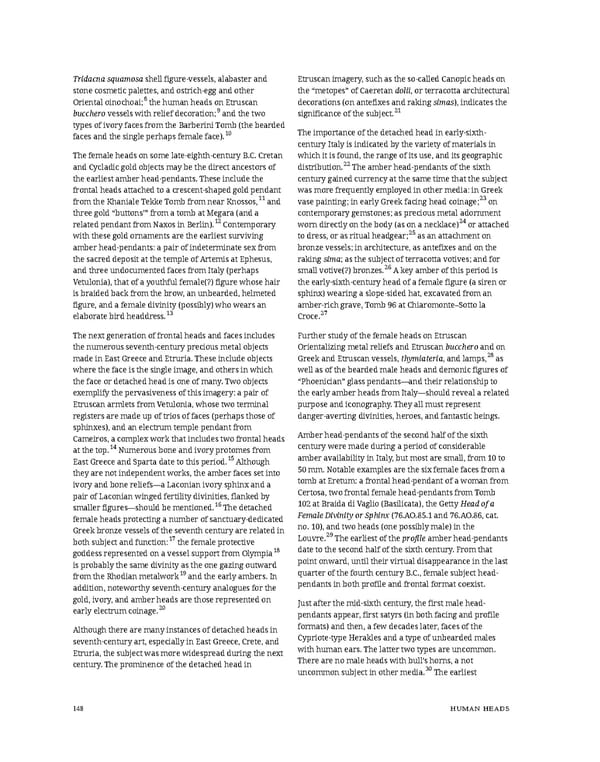Tridacna squamosashell figure-vessels, alabaster and Etruscan imagery, such as the so-called Canopic heads on stone cosmetic palettes, and ostrich-egg and other the “metopes” of Caeretan dolii, or terracotta architectural Oriental oinochoai;8 the human heads on Etruscan decorations (on antefixes and raking simas), indicates the buccherovessels with relief decoration;9 and the two significance of the subject.21 types of ivory faces from the Barberini Tomb (the bearded faces and the single perhaps female face).10 The importance of the detached head in early-sixth- century Italy is indicated by the variety of materials in The female heads on some late-eighth-century B.C. Cretan which it is found, the range of its use, and its geographic and Cycladic gold objects may be the direct ancestors of distribution.22 The amber head-pendants of the sixth the earliest amber head-pendants. These include the century gained currency at the same time that the subject frontal heads attached to a crescent-shaped gold pendant was more frequently employed in other media: in Greek from the Khaniale Tekke Tomb from near Knossos,11 and vase painting; in early Greek facing head coinage;23 on three gold “buttons’” from a tomb at Megara (and a contemporary gemstones; as precious metal adornment related pendant from Naxos in Berlin).12 Contemporary worn directly on the body (as on a necklace)24 or attached with these gold ornaments are the earliest surviving to dress, or as ritual headgear;25 as an attachment on amber head-pendants: a pair of indeterminate sex from bronze vessels; in architecture, as antefixes and on the the sacred deposit at the temple of Artemis at Ephesus, raking sima; as the subject of terracotta votives; and for and three undocumented faces from Italy (perhaps small votive(?) bronzes.26 A key amber of this period is Vetulonia), that of a youthful female(?) figure whose hair the early-sixth-century head of a female figure (a siren or is braided back from the brow, an unbearded, helmeted sphinx) wearing a slope-sided hat, excavated from an figure, and a female divinity (possibly) who wears an amber-rich grave, Tomb 96 at Chiaromonte–Sotto la elaborate bird headdress.13 Croce.27 The next generation of frontal heads and faces includes Further study of the female heads on Etruscan the numerous seventh-century precious metal objects Orientalizing metal reliefs and Etruscan bucchero and on made in East Greece and Etruria. These include objects Greek and Etruscan vessels, thymiateria, and lamps,28 as where the face is the single image, and others in which well as of the bearded male heads and demonic figures of the face or detached head is one of many. Two objects “Phoenician” glass pendants—and their relationship to exemplify the pervasiveness of this imagery: a pair of the early amber heads from Italy—should reveal a related Etruscan armlets from Vetulonia, whose two terminal purpose and iconography. They all must represent registers are made up of trios of faces (perhaps those of danger-averting divinities, heroes, and fantastic beings. sphinxes), and an electrum temple pendant from Cameiros, a complex work that includes two frontal heads Amber head-pendants of the second half of the sixth at the top.14 Numerous bone and ivory protomes from century were made during a period of considerable East Greece and Sparta date to this period.15 Although amber availability in Italy, but most are small, from 10 to they are not independent works, the amber faces set into 50 mm. Notable examples are the six female faces from a ivory and bone reliefs—a Laconian ivory sphinx and a tomb at Eretum: a frontal head-pendant of a woman from pair of Laconian winged fertility divinities, flanked by Certosa, two frontal female head-pendants from Tomb smaller figures—should be mentioned.16 The detached 102 at Braida di Vaglio (Basilicata), the Getty Head of a female heads protecting a number of sanctuary-dedicated Female Divinity or Sphinx (76.AO.85.1 and 76.AO.86, cat. Greek bronze vessels of the seventh century are related in no. 10), and two heads (one possibly male) in the 17 Louvre.29 The earliest of the profile amber head-pendants both subject and function: the female protective goddess represented on a vessel support from Olympia18 date to the second half of the sixth century. From that is probably the same divinity as the one gazing outward point onward, until their virtual disappearance in the last from the Rhodian metalwork19and the early ambers. In quarter of the fourth century B.C., female subject head- addition, noteworthy seventh-century analogues for the pendants in both profile and frontal format coexist. gold, ivory, and amber heads are those represented on Just after the mid-sixth century, the first male head- early electrum coinage.20 pendants appear, first satyrs (in both facing and profile Although there are many instances of detached heads in formats) and then, a few decades later, faces of the seventh-century art, especially in East Greece, Crete, and Cypriote-type Herakles and a type of unbearded males Etruria, the subject was more widespread during the next with human ears. The latter two types are uncommon. century. The prominence of the detached head in There are no male heads with bull’s horns, a not uncommon subject in other media.30 The earliest 148 HUMAN HEADS
 Ancient Carved Ambers in the J. Paul Getty Museum Page 157 Page 159
Ancient Carved Ambers in the J. Paul Getty Museum Page 157 Page 159